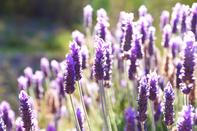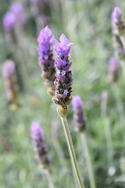Lavender is native to Western and Central Asia, Europe, the Mediterranean and North Africa. In this guide we will deal with the two main types used in the production of essential oil for medicinal and flavouring uses.

Namely the true lavender or English lavender and the Lavandin hybrids.
Scientific name: Lavandula Angustifolia
Common Name: Lavender, True Lavender or English Lavender
Scientific name: Lavandula Angustifolia x Lavandula latifolia
Common Name: Lavandin
Plant Description
The lavender plant is a perennial that grows to about 1200 mm in height and has long, spike like, grey green leaves with slightly serrated edges that get to about 40 to 50 mm long. The plant produces numerous side branches to form a bush. The flowers that form on the tips of the branches in a cylindrical bunch are a blue to lilac purple colour. Lavandin is a more prolific grower and produces more flowers than English lavender.
Uses
Lavender is used mainly for its essential oil. For every kilogram of fresh English lavender put through the distillation process about 5 to 8 millilitres of essential oil is produced. When Lavandins are distilled they produce about twice the oil but with a more medicinal fragrance because of its higher camphor content. The essential oil of English Lavender is prized by the perfume industry because of its floral scent.
Lavender oil is also used medicinally as an antiseptic and anti bacterial agent. The oil is good as an insect repellent and is also used in aromatherapy. The oil is also used as a flavouring agent by the food and beverage industry. Lavender is can also be dried as a fragrant potpourri and as dried flower arrangements.
Soil Requirements and Preparation
Lavender grows in a wide range of soils but grows best in a well drained coarse sandy to sandy loam soils with a pH of between 6.0 and 8. The True lavender grows best in the more alkaline soils and the Lavandin prefers lower pH, slightly acidic soils. Before any soil preparation is done a representative soil sample should be taken and sent to a laboratory for analysis and nutrient recommendations. Lavender has a relatively shallow root system and its roots rarely develop deeper than 300 mm.
Soils should be ripped to loosen the soil profile to about 400 mm to ensure good drainage. Rectify pH levels by adding lime if soils are too acidic and add manure or compost. Plough into the top 300 mm of soil about four to five weeks before planting. In the final days before planting add trace elements and a balanced pre plant fertilizer to the soil and disc harrow into the top 20 cm of soil. This will also clear any weeds that may have established. Install irrigation and if mulching is to be done this will now occur and then plant the seedlings.
Climate
Lavender is an evergreen plant that grows in warm dry Mediterranean climates and performs best in temperatures of between 20°C and 28°C. Lavender can be cultivated in dry climates where there is at least 500 mm of rain spread over the year, although performs best under permanent drip irrigation. It does grow near sea level but does better at higher altitudes with some growing as high as 1500 meters above sea level. Too high temperatures negatively affects flowering and oil quality.
Cultivars

There are two main types of lavender produced commercially. True or English lavenders that produce smaller flowers and less, but a better quality, oil and Lavandins, which are a hybrid and produce more flowers and essential oils per hectare. True lavender oil is superior and sells for higher prices.
There are many varieties of lavender so when choosing what to plant it is best to get the advice of the local extension officer and production specialists for the best variety for the production area and for the purpose and the target market.
Popular English or True lavender varieties are: Hidcote, Munstead, Jean Davis and Vera being the most popular.
Popular Lavandin varieties are: Abriali, Dutch Mill, Grappenmall, Grosso, Provence, Seal and Super.